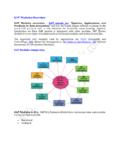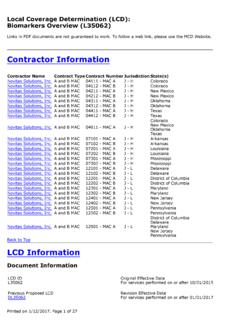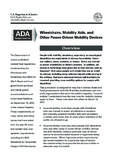Transcription of REASONABLE ACCOMMODATION: THE NEW …
1 1 REASONABLE accommodation : the new focus IN DISABILITY BIAS SUITS Betsy J. Beck I. overview The americans with disabilities act Amendments Act of 2008 ( ADAAA ) amended the ADA, the landmark disability statute that President George Bush signed into law in 1990. the new statute took effect on January 1, 2009. The ADAAA was enacted to restore the intent and protections of the ADA by making it easier for plaintiffs to establish that they are disabled. The law made a number of significant changes to broaden the number of individuals protected by the statute. It also directed the EEOC to amend its ADA regulation to reflect the changes. The final regulations were published in the Federal Register on March 25, 2011, and are codified at 29 Part 1630.
2 Prior to the enactment of the ADAAA, most of the focus in ADA litigation concerned the definition of disability. For this reason, the courts very often never reached the issue of whether an employer was obligated to make a REASONABLE accommodation to enable the plaintiff to perform the essential functions of his or her position. Now that the definition of disability has been expanded, pundits are predicting that REASONABLE accommodation issues will dominate courts attention in the near future. Included within these questions is to what extent a plaintiff must have requested an accommodation , whether the requested accommodation would change the essential functions of a position and, if not, whether providing the accommodation would impose an undue hardship upon the employer s business.
3 There has been and will be considerable uncertainty as to how to answer those questions, as can be demonstrated by the current move by the EEOC to address the ADA s impact of leave policies. Herein, we will review the current state of the ADA after the ADAAA. Next, we will discuss the general parameters of the duty to make REASONABLE accommodation . We will then address recent developments at the EEOC, the OFCCP and in court regarding the affirmative obligation to offer an individual with a disability a REASONABLE accommodation . In the conclusion, we will provide you with some guidance in considering your firm s obligation to make such REASONABLE accommodations. II. BASIC REQUIREMENTS AFTER THE 2008 AMENDMENTS A.
4 Under the ADAAA, more individuals with impairments will meet the disability threshold. The ADAAA retained the ADA s definition of disability, which is: An impairment that substantially limits one or more major life activities; a record of such impairment; or being regarded as having such an impairment. Pub. L. No. 110-325, Sec. 4, 3, 122 Stat. 3553. However, although the definition of disability remained the same, the ADAAA expanded its protection to a broader class of individuals. Congress found that persons with many types of impairments including epilepsy, diabetes, multiple sclerosis, major depression, and bipolar 2 disorder had been unable to bring ADA claims because they could not meet the ADA definition of disability.
5 The ADAAA explicitly rejected certain Supreme Court decisions and a portion of the EEOC regulations that it found had improperly narrowed the definition of disability. Congress set the tone in favor of employees when it said, the question of whether an individual s impairment is a disability under the ADA should not demand an extensive analysis. Id. So how has the ADAAA broadened the scope of the ADA? 1. It is now easier to prove that a disability substantially limits a major life activity. Some courts had determined that in order to be substantially limiting, an impairment needs to significantly restrict an individual in performing a major life function. However, the ADAAA clarifies that, A person is considered an individual with a disability for the purposes of the first prong of the definition when [one or more of] the individual s important life activities are restricted as to the conditions, manner, or duration under which they can be performed in comparison to most people.
6 Id. The EEOC s final regulations published on March 25, 2011, developed several rules of construction to determine whether the impairment substantially limits performance of a major life activity. Those rules of construction require the term substantially limits to be construed broadly in favor of coverage to the maximum extent permitted by the ADA. Moreover, an impairment need not prevent or severely or significantly limit a major life activity to be considered substantially limiting. The regulations state that the condition, manner and duration of the person s performance of the activity should be closely examined. For example, can the person perform the activity for only a brief period? Is it painful or otherwise difficult to perform the activity?
7 The EEOC s focus will be on whether the employer reasonably accommodated or discriminated against the employee, not whether the individual s impairment substantially limits the performance of a major life activity. Given this approach, a prudent employer will not focus on how to defeat an employee s request for an accommodation by arguing the employee s impairment is not substantially limiting. Rather, the prudent employer will assume the employee s impairment will be considered substantially limiting and proceed to the next step - namely, what REASONABLE accommodation , if any, should be considered? 2. Major life activities now include major bodily functions. The ADAAA provides that major life activities now include, but are not limited to, caring for oneself, performing manual tasks, seeing, hearing, eating, lifting, bending, speaking, breathing, learning, reading, concentrating, thinking, communicating, and working.
8 Id. Thus, the ADAAA considers even the most basic functions to be major life activities. It is also important to note that because concentrating and thinking are now major life activities that can be substantially limited by an impairment under the ADA, individuals with conditions such as Attention Deficit Disorder (ADD) and Attention Deficit Hyperactivity Disorder (ADHD) will have a much easier time of meeting their burden of proving disability. 3 3. A disability includes any impairment that is episodic or in remission if it would substantially limit a major life activity when active. An impairment that is episodic or in remission will be nevertheless considered a disability if it would substantially limit a major life activity when active. Thus, even in a dormant state, the impairment may be a disability under the new statute.
9 The final regulations include epilepsy, hypertension, asthma, diabetes, major depression, bipolar disorder, schizophrenia, and cancer as examples of impairments that would substantially limit a major life activity when active. However, employers should note that an individual might not need an accommodation during periods when his or her condition is in remission. In Hoffman v. Carefirst of Fort Wayne, Inc., 737 F. Supp. 2d 976 ( Ind. 2010), the court held that an employee with cancer in remission was considered disabled under the ADA. The court reasoned that because [the employee] had cancer in remission (and that cancer would have substantially limited a major life activity when it was active), [the employee] does not need to show that he was substantially limited in a major life activity at the actual time of the adverse employment action.
10 Id. at 985. 4. The ameliorative effects of mitigating measures cannot be taken into account when assessing whether an impairment substantially limits a person s major life activities. Employers and courts are now prohibited from taking into account mitigating measures, such as prescription drugs, medical supplies and equipment, hearing aids, and prosthetic limbs when deciding whether an individual has a covered disability. Thus, when applied to the ADD or ADHD examples mentioned above, an employer would not be able to consider the benefits the employee may reap from prescribed medications. However, employers may still consider vision impairment in its corrected state with contacts or eyeglasses. 5. Regarded as coverage is broader than ever. An individual can be protected by the ADA because the individual has an actual disability, a record of a disability, or because the employer incorrectly regards the individual as having a disability.






